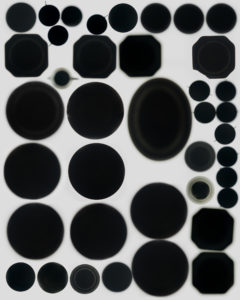May Day was my great grandmother’s birthday (1900) and my great grandfathers birthday (1896). She was a Swiss immigrant, he an Irish immigrant. They met at a May Day dance in New York. They were married a few years later in May, 1920. I use the chipped remains of their wedding china to make improvisational photographic compositions. Like many inherited china sets there are dishes long missing and broken. I arrange the surviving pieces as repeated photographic elements over and over in an infinite number of variations and visual relationships. I am looking for fugitive balance between presence and absence. The work speaks to a sense of precariousness and the emotional weight of inheritance and loss.
My photographic works reflect one moment in a long, slow process of erosion. I use photographic technology the wrong way–backlit and out of focus–to make objects appear as though they are sinking, fading away, or just out of grasp. I digitally stitch photographs together to create an unrealistic view of time and space. Objects are suspended in a reality where it is unclear whether they are waxing or waning, concave or convex, fleeting or persistent.
I propose a site-specific installation, titled “May Day,” involving wall panels covering a small room, alcove, closet, or on movable walls in a gallery space. I want to create an intimate space, resembling a mausoleum, ideally in a small room of roughly eight by eight feet or smaller. I am flexible with scale/size, because I will tailor wall panels specifically for the space. Each wall panel will be a unique improvisational china set composition (like those pictured in my example images). Each will be 60 inches tall and 4o inches wide (though width may vary depending on size of exhibition space). There will be four inches of space between each panel. Depending on the size of the exhibitions space, roughly eight wall panels will comprise the installation.
The example images submitted with this proposal give you a sense of what the wall panels will look like. However, the final work will be designed and created specifically for the exhibition space.
The wall panels will be printed on matte adhesive inkjet paper, which I have used for exhibition in the part. The adhesive is not permanent and doesn’t damage the walls.
Due to unique installation requirements, and because I live in Winona, I plan to help with the installation of my work. I would be happy to participate in the conference and/or an artist talk, panel or round table.


